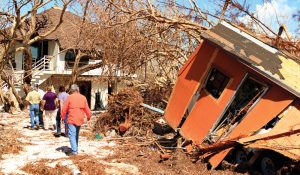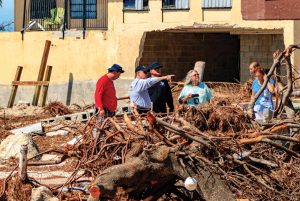Structural Engineering Emergency Response
As structural engineers, we make a difference in peoples’ lives every day as we help to ensure society’s health, safety, and welfare. This past year, many structural engineers took this responsibility to another level in the aftermath of Hurricanes Harvey (in Texas) and Irma (in Florida).
As reflected in the photos on this page, structural engineers took a leadership role as 2nd Responders to these natural disasters through the Structural Engineers Emergency Response (SEER) Program. Structural engineers performed damage and safety assessments of communities devastated by the hurricanes to determine whether structures were suitable for re-habitation. In response to Hurricane Harvey, 53 members of the SEER program volunteered to provide responder assistance, with 51 actively deployed to assess more than 13,000 structures. In response to Hurricane Irma, 84 members of the SEER program volunteered to provide responder assistance, with 24 actively deployed to assess more than 5,000 structures.
The SEER Program is a comprehensive nationwide initiative aimed at locating and deploying properly trained design professionals into communities after disasters to assist with Applied Technology Council (ATC) style damage/safety assessments. At the state level, SEER Committees, as part of their State Structural Engineers Association (SEA), work to recruit and educate members to become 2nd responders. At the national level, NCSEA and its SEER Committee work to establish relationships with allied organizations to support its SEA SEER Committees by focusing on the following four issues:
- SEER Committees facilitate and deliver requisite training to SEA members so they can be certified as 2nd responders. This training is offered online through the NCSEA CalOES Structural Assessment Course or FEMA’s National Incident Management System and in person through the International Code Council (ICC) Disaster Response Inspector Course.
- Roster Management consists of compiling and maintaining the comprehensive national database of trained 2nd responders through the SEER 2nd Responder Roster at www.ncsea-seer.com. This roster is a fully interactive database that can be updated as needed by the participant and searched by SEER Committee Members to obtain a listing of participants by certification and location.
- Assistance Coordination consists of coordinating and providing 2nd responder assistance to authorities having jurisdiction (AHJs) or other stakeholders. This assistance ranges from providing lists of properly trained individuals to providing coordination and logistical assistance when needed.
- SEER Committees provide advocacy by educating AHJs, allied associations, the public, and engineers on the benefits of having structural engineers participate in 2nd response.
In support of these four initiatives, NCSEA and the ICC signed an agreement at the end of 2017 to join forces on the 2nd Responder Roster to create a single database between the two organizations of volunteers willing and able to serve when disasters strike.
The SEER 2nd Responder Database is only as good as the structural engineers who are willing and able to volunteer and have created and updated their records. If you have post-disaster assessment training, create a record today. If you are interested in bringing post-disaster assessment training to your local area, reach out to your SEA’s SEER Committee or reach out to the national NCSEA SEER Committee.
Once a disaster strikes, it may be too late to volunteer. As 2nd Responders, structural engineers can continue to make a difference and ensure the health, safety, and welfare of society.
For more information on the SEER Program, visit the NCSEA SEER Committee website at www.ncsea.com/committees/seercommittee, the SEER 2nd Responder Roster at www.ncsea-seer.com or the NCSEA Emergency Response website at www.ncsea.com/resources/emergencyresponse.▪


